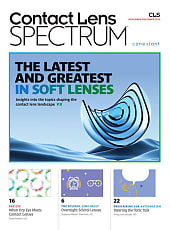While considered controversial by some, due to inconsistent study results, several studies do establish diabetes as a risk factor for glaucoma1, and that diabetes with coexisting glaucoma increases the risk of developing diabetic retinopathy (DR).2-4
Diabetes as a Risk Factor
The underlying mechanisms of diabetes as a risk factor for glaucoma are microvascular damage, oxidative stress, and insulin resistance.5,6
Specifically, all contribute to optic nerve vulnerability and elevated intraocular pressure (IOP):
- Microvascular damage. Chronic glycemic dysregulation leads to microangiopathy, which affects the autoregulation of blood flow to the optic nerve. Reduced blood perfusion to the optic nerve head may accelerate glaucomatous damage even in patients who have normal IOP.
- Oxidative stress and neuroinflammation. Diabetes induces oxidative stress, which leads to retinal ganglion cell apoptosis. Increased levels of inflammatory cytokines from retinal ganglion cell apoptosis further contribute to optic nerve degeneration.
- Dysregulated aqueous outflow. Hyperglycemia may impair trabecular meshwork function, leading to increased resistance to aqueous humor outflow and, therefore, elevated IOP.7
Diabetes Coexisting With Glaucoma
The interplay between diabetes and glaucoma creates a cycle of vascular dysfunction and retinal damage, elevating the risk of DR and worsening its severity.8
This occurs via these mechanisms:
- Compromised retinal circulation. Glaucoma exacerbates retinal ischemia by further reducing blood perfusion in a retina already compromised by diabetes. This may accelerate the onset and progression of DR, increasing the likelihood of proliferative DR.
- Structural damage. Progressive optic nerve damage in glaucoma may decrease retinal nerve fiber layer (RNFL) thickness, which is shown to correlate with DR severity.9 This suggests a synergistic effect in which both diseases amplify neuronal loss.
- Reduced tolerance to IOP fluctuations. In diabetics who have glaucoma, retinal vasculature may be less capable of adapting to IOP fluctuations. This can result in greater susceptibility to retinal hypoxia, neovascularization, and, eventually, vision-threatening complications, such as vitreous hemorrhage and tractional retinal detachment.

Related Clinical Implications as a Risk Factor
Understanding that diabetes can be a risk factor for glaucoma and how it’s coexistence with the silent thief of sight can increase DR underscores the necessity of a proactive, approach by the optometrist. This approach is comprised of:
- Vigilance in following diabetic patients closely. Given the risk factors highlighted, the OD should keep tabs on these patients, particularly those who have additional risk factors, such as a family history, high myopia, corticosteroid use, thin pachymetry, or reduced corneal hysteresis, for glaucoma.
- Screening routinely for glaucoma. Optometrists should regularly monitor IOP, RNFL thickness, and visual fields in diabetic patients, when indicated.
- Encouraging systemic glucose control. Doing so may reduce the risk of DR progression.
- Utilizing advanced imaging. ODs should incorporate imaging modalities to monitor disease progression and conversion closely, and guide management decisions. OM
References
1. Zhao D, Cho J, Kim MH, Friedman DS, Guallar E. Diabetes, fasting glucose, and the risk of glaucoma: a meta-analysis.Ophthalmology. 2015;122(1):72-78. doi:10.1016/j.ophtha.2014.07.051.
2. Abikoye TM, Oluleye TS, Aribaba OT, Musa KO, Idowu OO, Onakoya AO. Is primary open-angle glaucoma a risk factor for diabetic retinopathy?.Int Ophthalmol. 2020;40(12):3233-3240. doi:10.1007/s10792-020-01507-0.
3. Chauhan MZ, Elhusseiny AM, Kishor KS, et al. Association of Primary Open-Angle Glaucoma with Diabetic Retinopathy among Patients with Type 1 and Type 2 Diabetes: A Large Global Database Study.Ophthalmology. 2024;131(7):827-835. doi:10.1016/j.ophtha.2024.01.016
4. Lee, R., Wong, T. Y., Sabanayagam, C., Tey, G., Cheung, N., Aung, T., & Tai, E. S. (2013). Association between glaucoma and diabetic retinopathy: a systematic review and meta-analysis. Ophthalmology, 120(12), 2459–2469.
5. Zheng Z, Yu X. Insulin resistance in the retina: possible implications for certain ocular diseases.Front Endocrinol (Lausanne). 2024;15:1415521. Published 2024 Jun 17. doi:10.3389/fendo.2024.1415521
6. Song BJ, Aiello LP, Pasquale LR. Presence and Risk Factors for Glaucoma in Patients with Diabetes.Curr Diab Rep. 2016;16(12):124. doi:10.1007/s11892-016-0815-6.
7. Singh S, Patel NA, Soundararajan A, Pattabiraman PP. High Glucose-Induced Transcriptomic Changes in Human Trabecular Meshwork Cells. Preprint.Res Sq. 2024;rs.3.rs-5690041. Published 2024 Dec 24. doi:10.21203/rs.3.rs-5690041/v1.
8. Community for Diabetes and Glaucoma Study (CDGS). Consensus statement: Diabetes and glaucoma. Diabetes Metab Syndr Clin Res Rev. 2017;11(Suppl 1):S109-S117.
9. Brock C, Wegeberg AM, Nielsen TA, et al. The Retinal Nerve Fiber Layer Thickness Is Associated with Systemic Neurodegeneration in Long-Term Type 1 Diabetes.Transl Vis Sci Technol. 2023;12(6):23. doi:10.1167/tvst.12.6.23




